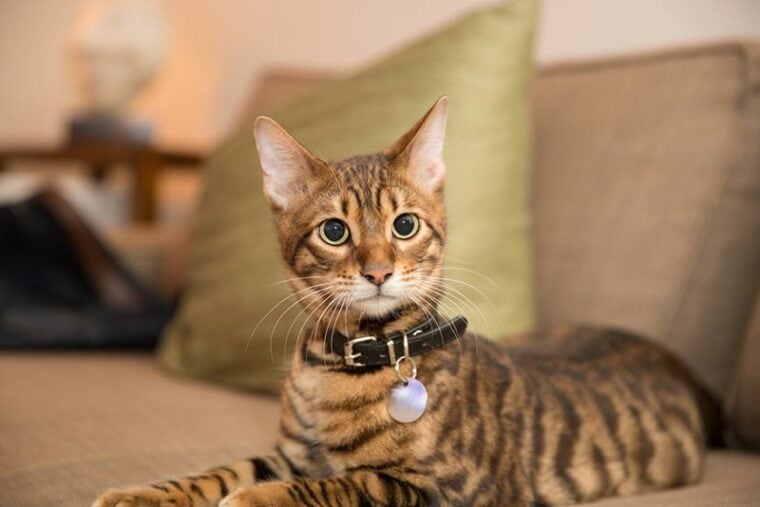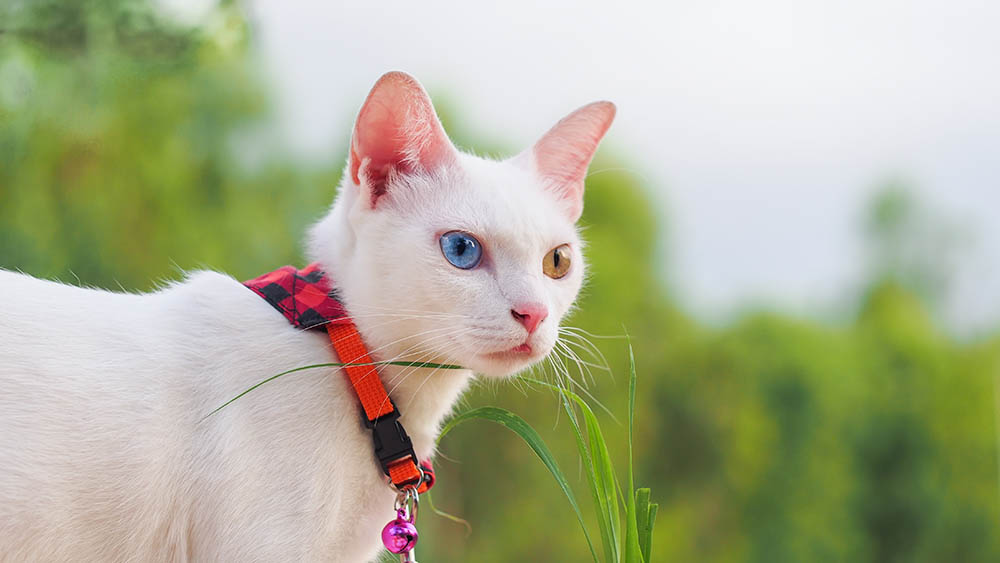
Click to Skip Ahead
A cat collar is more than a cute accessory; getting your cat used to wearing one can be helpful for many reasons. Cats aren’t as accepting as dogs but are more independent and may feel suspicious about having something around their neck.
Whether your cat is an outdoor or indoor cat, a collar can help keep your kitty safe. If your cat has objected to a collar or this is your first time trying one, the good news is that with a bit of patience and commitment, you can help your cat get used to a collar. In this article, we talk about cat collars and include tips to help your cat get used to wearing one.
Before You Start – How to Put a Collar On
To help your cat get used to its collar, it’s no surprise you have to put it on! Start by removing any bells, tags, or charms, so you have only the collar. Once your cat is used to its collar, you can introduce these additions again.
Adjust the collar to suit the size of your cat’s neck. If you are replacing your cat’s collar, you can use the old one to determine the right size, but if it is the first collar, there should be two fingers between the collar and your cat’s neck.
Get into a position where your cat’s head will be facing you. Try your best; we understand that some cats don’t keep still for longer than 5 seconds! Hold the collar’s ends in each hand, gently slide it under your cat’s chin, and bring it together at the top swiftly with little hesitation.
You may not get this down on the first try, especially if your cat is resistant to wearing a collar, but don’t worry, you can follow these tips to help get your cat used to a collar.

 How to Get Your Cat Used to Their Collar in 5 Steps
How to Get Your Cat Used to Their Collar in 5 Steps
1. Choose the Right Collar
The most important tip is to choose the right collar for your cat. The most appropriate type of collar is a breakaway or safety collar that can allow for an easy escape if your cat gets caught in something.
Some other things to consider when choosing a suitable collar are the materials. Try selecting an elastic collar that will also assist if your cat becomes stuck and provide more room for growth. It should also be snug fitting: not too tight but also not too loose that it moves over your cat’s head.
If the collar is the right size and comfortable, it is more likely that your cat will get used to it faster.
The best cat collars are sturdy, comfortable, and safe. Our favorite is Hepper's Breakaway Collar, a well-designed collar made from 100% natural hemp webbing that softens as your cat wears it. Featuring a quick-release buckle, adjustable slip-locks, and a jingle bell, this collar is as practical as it is stylish!
At Pet Keen, we've admired Hepper for many years, and decided to take a controlling ownership interest so that we could benefit from the outstanding designs of this cool cat company!
2. Get Your Cats Scent onto its Collar
Cats are sensitive to scents. They produce a variety of scents and can detect them in their surroundings. Your cat will feel more comfortable with the new collar if it has an element of familiarity, like its own aroma.
Before introducing the collar, you could rub it against its blanket or your cat’s face with a cloth and then rub it onto the collar. This will help pass their scent onto the collar, which can help your cat get comfortable with it faster. Cats find their scent reassuring and use it to make an unfamiliar environment feel more comfortable.
3. Introduce the Collar
Once you have found a suitable collar for your cat, you will need to introduce it. Start by placing it on the ground, so your cat can sniff it out and investigate it. When you do this, choose a time when your cat is calm and happy; the worst time to introduce a collar is when your cat is stressed.
You can play with your cat and its favorite toys or give your cat some extra attention and cuddles until you notice it is happy and relaxed. Also, choose an area where your cat feels most comfortable; it could be on your lap or its favorite sleep spot.
When introducing the collar, do so slowly and gently. If you rush to put it on, it could scare your cat, which can result in your cat trying to shake it off or resisting it. Furthermore, your cat may associate the collar with something negative and avoid it.

4. Allow Your Cat Time To Get Used to the Collar
Once you have placed the collar around your cat’s neck, allow it to get used to it. It is normal for them to feel a little disoriented but try not to take it off immediately. Distract your cat with food or playtime to help your cat forget about it.
Use positive reinforcement throughout the process, including praise and cuddles. Continue to repeat this step daily for longer periods until your cat gets used to it.
5. Try Again
Some cats may take some time to accept a collar. Consistency and patience are key; eventually, your cat will realize that resisting is pointless.
If your cat manages to get its collar off on its own, skip the treat. Give your cat a break before trying again, and know that it may take some time before your cat is comfortable with wearing a collar all day.

Benefits of Wearing a Collar
Collars aren’t for every cat or every owner, but there are some great benefits to getting your cat used to one.
Cats sporting a collar signal that they are someone’s pet which is especially helpful if they go missing. In addition to the collar, a tag is particularly useful in identifying the cat’s name, where it lives, and a contact for the owner. The tag could also include specific dietary requirements or medical conditions to assist anyone who may find your cat.
A bell is also a helpful addition to a cat collar as it can alert you when your cat is around, and it can scare off birds and rodents making it harder for your cat to catch them, which reduces the chances of an unwanted gift, as well protecting the bird life.
Other Factors in Choosing a Collar
Naturally, it is essential to have a collar that fits your cat well and is safe, but a few other factors are involved in choosing a collar for your cat.
Some collars are available in a reflective material which can help wander cats who end up close to a busy road. The car lights will reflect off the collar, making them aware of your curious kitty.
Colors and patterns are the least important aspect but choosing a color and pattern is the fun part. You can choose something that matches your cat’s personality or use a gender-appropriate color to indicate to others that your cat is male or female.
Conclusion
Your cat may protest its collar at first, but in time, it will surrender and become familiar with having a collar around its neck. Your cat’s collar should be safe, and your cat shouldn’t associate it with something negative. Once the collar is comfortable for your kitty, you can add a bell and tag and even accessorize your kitty with some fun colors and patterns. You can have peace of mind knowing that your cat is tagged and safe while it prowls around exploring, playing, and hunting.
Featured Image Credit: stockelements, Shutterstock


 How to Get Your Cat Used to Their Collar in 5 Steps
How to Get Your Cat Used to Their Collar in 5 Steps




